|
|
|
Sort Order |
|
|
|
Items / Page
|
|
|
|
|
|
|
| Srl | Item |
| 1 |
ID:
114581
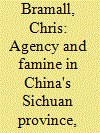

|
|
|
|
|
| Publication |
2011.
|
| Summary/Abstract |
A revisionist literature on the Great Chinese Famine has emerged in recent years. These revisionists focus primarily on the question of agency. They claim that that neither poor weather nor the excesses of local cadres can explain the extent of mortality; rather, responsibility lies squarely with Mao and the CCP leadership. Using county-level data on mortality, output, rainfall and temperature for Sichuan province, I argue that this revisionist view is unconvincing. Weather admittedly played only a minor role, and the zealotry of the Party centre contributed significantly to the death toll. However, variations in mortality between Sichuan's counties appear to have been essentially random - suggesting that differences in local cadre responses to central government policy were decisive in determining the scale of famine.
|
|
|
|
|
|
|
|
|
|
|
|
|
|
|
|
| 2 |
ID:
188164
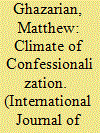

|
|
|
|
|
| Summary/Abstract |
After the 1877–78 Russo-Ottoman War, the Ottoman Empire saw the rise of ethnic and sectarian clashes in Anatolia, the Balkans, and elsewhere, and the task of explaining that rise remains unfinished. Many have examined the intellectual formations of ethnic and sectarian solidarities after 1878, but the availability of new ideas cannot alone account for their widespread uptake. Why after 1878 did ordinary people respond more to calls upon ethnic and sectarian solidarity? Drawing on sources surrounding the 1879 famine in the Ottoman East, this article steps away from imperial metropoles to examine overlapping environmental, financial, and technological disjunctures. Adopting the methods of political ecology, the article underscores the simultaneous effects of drought, sovereign default, and an influx of modern weapons, each of which imposed uneven hardships along ethno-religious lines. Together, they created a climate of lived confessionalization that highlighted the communal categories upon which emergent movements called.
|
|
|
|
|
|
|
|
|
|
|
|
|
|
|
|
| 3 |
ID:
136288
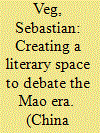

|
|
|
|
|
| Summary/Abstract |
Since the scar literature of the early 1980s, fiction and fictionalised autobiography have played an important role in bringing to light the mass violence of the Cultural Revolution. However, these texts remained within a well-defined framework in which the political system itself was not questioned. Over the last decade, by contrast, the Chinese literary field has focused more specifically on the 1950s, with works such as Yang Xianhui’s Chronicles of Jiabiangou (Tianjin, 2002), and Yang Jisheng’s Tombstone (Hong Kong, 2008). This paper focuses on Yan Lianke’s Four Books (Hong Kong, 2010), a full-fledged fictionalisation in a fantastic mode of the famine of the Great Leap Forward in a village on the Yellow River. Considering literature in the context of theories of the public sphere, it suggests that Yan’s book aims to broaden decisively the discussion on certain previously out-of-bounds aspects of the Mao era, an aim only partially thwarted by its failure to be published within mainland China. Four Books, like Yang Jisheng and Yang Xianhui’s works, thus represents an attempt to call into question the original legitimacy of the PRC polity and to create debate within the Chinese-speaking public sphere on the foundations of the current regime.
|
|
|
|
|
|
|
|
|
|
|
|
|
|
|
|
| 4 |
ID:
192041


|
|
|
|
|
| Summary/Abstract |
warfare. Oxen have been looted and killed, farm inputs and tools destroyed by Ethiopian and Eritrean soldiers. Farmers felt vulnerable out in the open with their oxen. To produce, farmers evaluated risks involved with ploughing and organised lookouts. Overall, a large part of the land had been tilled in difficult conditions, and crops sown that require minimal management, without fertiliser, what led to low yields. True Colour Composite images, produced from Sentinel satellite imagery show that smallholder irrigation schemes were operational. There was a shift from commercial crops to cereals. The situation in western Tigray was particular, as there has been ethnic cleansing of the population and often the 2020 rainfed crops had even not been harvested. Overall, our findings show that the Tigrayan smallholder farming system is resilient, thanks to community self-organisation, combining common strategies of agrarian societies in wartime: spatio-temporal shift in agricultural activities to avoid the proximity with soldiers and shifts in crop types. Rather unique is the relying on communal aid, while the blockade of the Tigray region made that outmigration and off-farm income were no options for the farmers.
|
|
|
|
|
|
|
|
|
|
|
|
|
|
|
|
| 5 |
ID:
095318
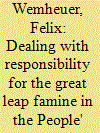

|
|
|
|
|
| Publication |
2010.
|
| Summary/Abstract |
In the aftermath of the famine in 1962, Mao Zedong took formal responsibility for the failure of the Great Leap Forward in the name of the central government. Thousands of local cadres were made scapegoats and were legally punished. This article focuses on the question of how the different levels of the Chinese state, such as the central government, the province and the county, have dealt with the question of responsibility for the famine. The official explanation for the failure of the Great Leap will be compared to unofficial memories of intellectuals, local cadres and villagers. The case study of Henan province shows that local cadres are highly dissatisfied with the official evaluation of responsibility. Villagers bring suffering, starvation and terror into the discourse, but these memories are constructed in a way to preserve village harmony. This article explains why these different discourses about responsibility of the famine are unlinked against the background of the "dual society"; the separation between urban and rural China. Finally, it will be shown that the Communist Party was unable to convince parts of society and the Party to accept the official interpretation.
|
|
|
|
|
|
|
|
|
|
|
|
|
|
|
|
| 6 |
ID:
192993


|
|
|
|
|
| Summary/Abstract |
This article is concerned with interregional trade dynamics between Elam and Mesopotamia in the early to mid-first millennium BC. During the seventh century BC, two great famines in the Neo-Elamite kingdom, of which climatological changes were a major cause, were documented in the textual records. An era of megadrought made grain procurement from the neighboring regions essential to feed the Neo-Elamite lowland population. This article further explores the impact of the two Neo-Elamite famines and “drought of the century” on the commercial and political mechanisms in the Upper Persian Gulf region.
|
|
|
|
|
|
|
|
|
|
|
|
|
|
|
|
| 7 |
ID:
184210


|
|
|
|
|
| Summary/Abstract |
The 17th century was a period of transition in world history. It was marked globally by social movements emerging in response to widespread drought, famine, disease, warfare, and dislocation linked to climate change. Historians have yet to situate Safavid Iran (1501–1722) within the “General Crisis.” This article, coauthored by an environmental historian and a climate scientist, revisits primary sources and incorporates tree-ring evidence to argue that an ecological crisis beginning in the late 17th century contributed to the collapse of the imperial ecology of the Safavid Empire. A declining resource base and demographic decline conditioned the unraveling of imperial networks and the empire's eventual fall to a small band of Afghan raiders in 1722. Ultimately, this article makes a case for the connectedness of Iran to broader global environmental trends in this period, with local circumstances and human agency shaping a period of acute environmental crisis in Iran.
|
|
|
|
|
|
|
|
|
|
|
|
|
|
|
|
| 8 |
ID:
106921
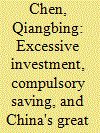

|
|
|
|
|
| Publication |
2011.
|
| Summary/Abstract |
This paper investigates the roles of excessive investment and compulsory saving in causing China's great famine during the period of 1959-1961. China initiated its ambitious industrialization campaign in 1958 under the false illusion that the agricultural sector would be able to provide sufficient savings. When the illusion proved to be false, a large number of industrial projects were left incomplete. However, since the economic returns for completing the half-done projects were high, central planners maintained high levels of grain procurement and urban labor force to complete these projects, even when famine became widespread. In addition, some political factors also contributed to the insufficient response by the central planners to the famine. The high grain procurement enforced by the State, compounded by other factors such as weather calamity, caused the most deadly famine in human history.
|
|
|
|
|
|
|
|
|
|
|
|
|
|
|
|
| 9 |
ID:
186005


|
|
|
|
|
| Summary/Abstract |
This article examines governments' responses to food crises and famines in the nondemocratic world. After the sudden collapse of the Soviet Union, many of the remaining communist countries encountered an unprecedented level of food shortage and economic hardship, which, in turn, expedited or led to regime collapse. However, Cuba and North Korea are striking cases that have managed to survive the extreme situations from the 1990s onward. In this comparative-historical research, I argue that although the two countries implemented different coping strategies in light of domestic food distribution and international aid inducement, similar outcomes are observed in terms of regime survival. Despite the varied strategies, the state-mandated food politics were commonly mobilized through public rationing in these countries during the Cold War. This pre-crisis statecraft effectively disempowered the people, leaving them with a strong dependency on the state food systems and a weak voice of complaint against their governments.
|
|
|
|
|
|
|
|
|
|
|
|
|
|
|
|
| 10 |
ID:
095566
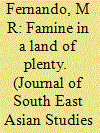

|
|
|
|
|
| Publication |
2010.
|
| Summary/Abstract |
This paper is an effort to examine the dynamics of a major famine in the private domains of Indramayu and Kandanghaur in 1883-84, which was reportedly a result of drought, but a closer look at the evidence, including a unique survey of peasant families engulfed in the famine, reveals a rather complex situation. The local peasantry confined to a narrow subsistence economy found its food supply being seriously undermined by the landlords' efforts to extract more and more rice for sale at a time when Java was being closely drawn into the world market.
|
|
|
|
|
|
|
|
|
|
|
|
|
|
|
|
| 11 |
ID:
191065
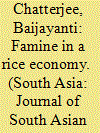

|
|
|
|
|
| Summary/Abstract |
This paper analyses the conjuncture of factors that led to famines in late eighteenth century Bengal, a province in which, due to the fluvial ecology and monsoonal climate, the cultivation of rice predominated. I demonstrate that the exclusive dependence on rice crops created conditions of agricultural insecurity, which in turn was taken advantage of by merchants and hoarders of grain in a bid to profit from artificially enhanced prices. The East India Company, acquiring political authority in Bengal in the mid eighteenth century, was unable to break through the monopolies of the grain dealers. In addition, its experiment with grain storage in large public granaries (golas), intended to overcome food shortages, also failed on account of mounting costs and the irrevocable tension between laissez-faire and state interventionism, which ultimately led to the abandonment of the granary system. I argue that a combination of rice monoculture, mercantile strategies, and lack of effective state intervention was ultimately responsible for transforming natural calamities and the ensuing food shortages into full-scale famines in Bengal in the eighteenth century.
|
|
|
|
|
|
|
|
|
|
|
|
|
|
|
|
| 12 |
ID:
103935


|
|
|
|
|
| Publication |
2011.
|
| Summary/Abstract |
In this paper, I investigate the long term effects of China's Great Famine in 1959-1961 on cohorts affected by the famine in the first year of life. Using China's 2000 population census data and after controlling for positive fertility selections in the famine, I find that women exposed to the famine in the first year of life had a lower probability of completing high school and lived in less wealthy households. I do not find any significant effects of the famine on men. In addition, I find that if positive fertility selections are not controlled for, the negative effects become weaker.
|
|
|
|
|
|
|
|
|
|
|
|
|
|
|
|
| 13 |
ID:
098105


|
|
|
| 14 |
ID:
177977
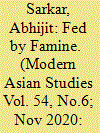

|
|
|
|
|
| Summary/Abstract |
This article demonstrates how the Great Bengal Famine of 1943–1944 and relief activism during it fed the politics of the Hindu right, a development that has not previously received much scholarly attention. Using hitherto unused primary sources, the article introduces a novel site to the study of communal politics, namely, the propagation of Hindu communalism through food distribution during a humanitarian crisis. It examines the caste and class bias in private relief and provides the first in-depth study of the multifaceted process whereby the Hindu Mahasabha used the famine for political purposes. The party portrayed Muslim food officials as ‘saboteurs’ in the food administration, alleged that the Muslim League government was ‘creating’ a new group of Muslim grain traders undermining the established Hindu traders, and publicized the government's failure to avert the famine to prove the economic ‘unviability’ of creating Pakistan. This article also explores counter-narratives, for example, that Hindu political leaders were deliberately impeding the food supply in the hope that starvation would compel Bengali Muslims to surrender their demand for Pakistan. The politics of religious conversion played out blatantly in famine-relief when the Mahasabha accused Muslim volunteers of converting starving Hindus to Islam in exchange for food, and demanded that Hindu and Muslim famine orphans should remain in Hindu and Muslim orphanages respectively. Finally, by dwelling on beef consumption by the army at the time of an acute shortage of dairy milk during the famine, the Mahasabha fanned communal tensions surrounding the orthodox Hindu taboo on cow slaughter.
|
|
|
|
|
|
|
|
|
|
|
|
|
|
|
|
| 15 |
ID:
096277
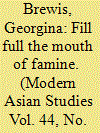

|
|
|
|
|
| Publication |
2010.
|
| Summary/Abstract |
This paper considers non-governmental famine relief in India during 1896-1898 and 1899-1901. It details the efforts of a broad spectrum of middle-class Indians, Christian missionaries, British non-officials and off-duty civil servants who were drawn into voluntary service on semi-official committees which were responsible for distributing record sums raised through international appeals. It also explores the extension of relief work by independent agencies in the 1890s. The paper considers evolving British attitudes to indigenous relief methods and the sometimes fraught relations between government and voluntary agencies. It suggests that voluntary famine relief activities during the 1890s mark a transition from traditional religious philanthropy to organised social service. Voluntary relief at this time differed from earlier responses to famine hunger because it was marked by fundraising, co-operation with other agencies and the personal service of volunteers. In conclusion, it is shown that participation in relief in the 1890s inspired a new generation of educated Indians to channel their nationalism into practical social service after 1900.
|
|
|
|
|
|
|
|
|
|
|
|
|
|
|
|
| 16 |
ID:
124585
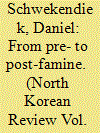

|
|
|
|
|
| Publication |
2013.
|
| Summary/Abstract |
Purpose-In the 1990s, North Korea experienced a national crisis that evolved into a famine. This paper explores the trends in underweight among preschool children measured from the pre- to the post-famine period.
Design-This research employs nutrition surveys carried out in North Korea in 1987, 1997, 1998, 2000, 2002, 2004, 2009 and 2012.
Findings-This paper shows that the country now has reached a pre-crisis level, indicating that children today are faring as well as they were during the Cold War. However, underweight rates are 24 times higher in North Korea compared to South Korea. More important, the UN targets an underweight rate of 9 percent in East Asia, but the rate is as high as 15 percent in North Korea, implying that further efforts are needed.
Originality-This paper provides rare evidence on the long-term trend in underweight among North Korean children. This is also the first paper that compares underweight rates of contemporary North Korean children with their South Korean peers.
|
|
|
|
|
|
|
|
|
|
|
|
|
|
|
|
| 17 |
ID:
082935
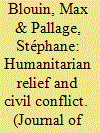

|
|
|
|
|
| Publication |
2008.
|
| Summary/Abstract |
The authors examine the effects that famine relief efforts (food aid) can have in regions undergoing civil war. In the model, warlords seize a fraction of all aid entering the region. How much they can loot affects their choice of army size; therefore the manner in which aid is delivered influences warfare. The authors identify a delivery plan for aid that minimizes total recruitment in equilibrium
|
|
|
|
|
|
|
|
|
|
|
|
|
|
|
|
| 18 |
ID:
128555


|
|
|
| 19 |
ID:
184100
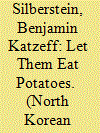

|
|
|
|
|
| Summary/Abstract |
This article seeks to investigate differences and similarities in how communist states respond to famine conditions, focusing on North Korea as a central case study. The purpose is to understand how North Korean government propaganda conceived of the reasons for, and the solutions to, the famine of the 1990s.
|
|
|
|
|
|
|
|
|
|
|
|
|
|
|
|
| 20 |
ID:
106757
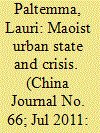

|
|
|
|
|
|
|
|